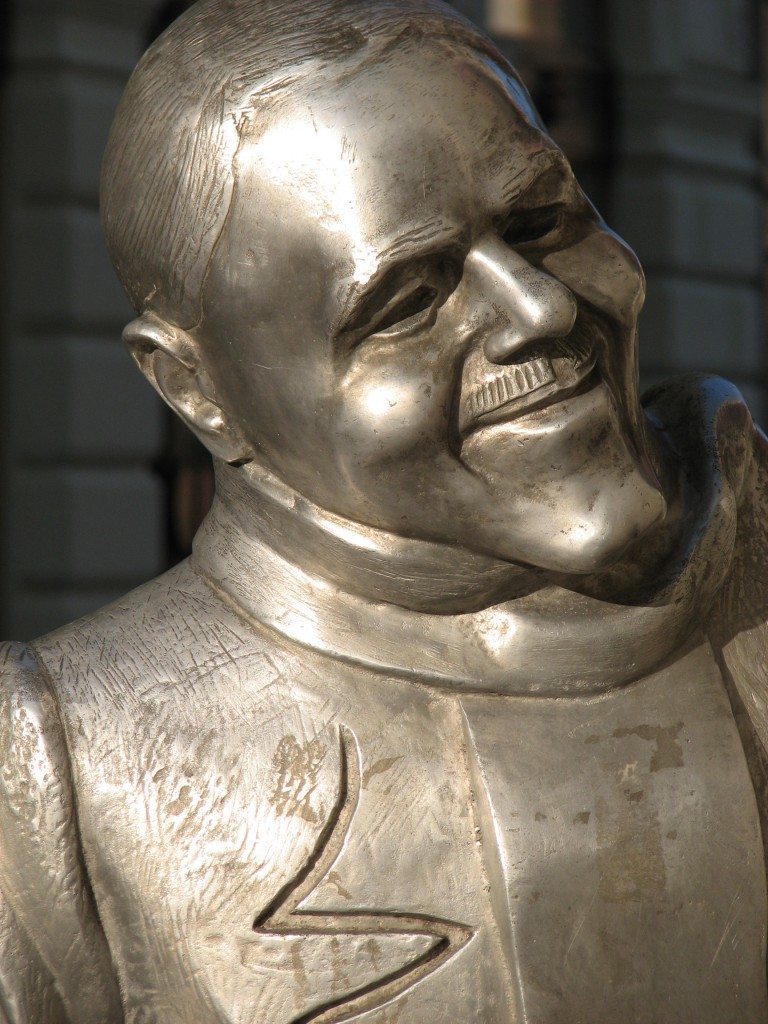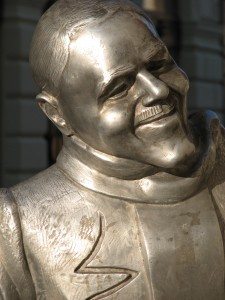 Our only goal for the trip was that it had to be to Spain so that the girls could practice their Spanish. If it was southern Spain, we could take advantage of the slightly warmer February temperatures, but it really didn’t matter. But then, after a little internet travel agenting, Ashley found a Ryan Air flight for 0.01 euros per person one-way. It didn’t matter that it left from Bratislava, an hour train ride from Vienna, or arrived in a small city outside of Barcelona, one of the only places in Spain that we’ve been already. For our budget travel cred, we had to be able to say that we took a vacation for 4 cents – even though after fees and taxes it was more like $100 each.
Our only goal for the trip was that it had to be to Spain so that the girls could practice their Spanish. If it was southern Spain, we could take advantage of the slightly warmer February temperatures, but it really didn’t matter. But then, after a little internet travel agenting, Ashley found a Ryan Air flight for 0.01 euros per person one-way. It didn’t matter that it left from Bratislava, an hour train ride from Vienna, or arrived in a small city outside of Barcelona, one of the only places in Spain that we’ve been already. For our budget travel cred, we had to be able to say that we took a vacation for 4 cents – even though after fees and taxes it was more like $100 each.
So we left for Bratislava after school on Friday afternoon, intending to see the Slovakian capital before our flight to Spain on Sunday. It took as much time to get to the train station of the other side of Vienna as it took to get to Bratislava, and the scene outside the Bratislavan train station had me worried that the dark tales of tourists being prey to post-communist violence were true. But five tram stops later we found the old city, with romantic cobblestone alleys lined with restaurants and bars, with a clock tower sometimes visible above, and I my 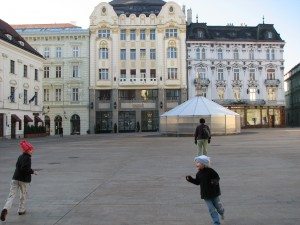 anxiety was gone. We eventually found the alley leading to the apartment I had rented through the internet – a recently refurbished one-bedroom place, one floor up and off a small courtyard. Down another alley we found a restaurant where we had traditional Slovak and Hungarian dishes, along with the ubiquitous pizza and pasta. In the morning, we explored more alleys and the Mayor’s palace, almost alone. The sun was out and around every corner was another photo opportunity. We found the Roland Café off of the main square for breakfast, and discovered hot chocolate so thick and chocolaty, that it bears little resemblance to the powdery stuff I make after skiing at home. Next door to the Roland is the Shoko Café, where later we find that they only serve chocolate – hot, cold, hard, and soft. And they have a four-tiered chocolate fountain in the window. The hot chocolate alone is worth the trip here, especially in February.
anxiety was gone. We eventually found the alley leading to the apartment I had rented through the internet – a recently refurbished one-bedroom place, one floor up and off a small courtyard. Down another alley we found a restaurant where we had traditional Slovak and Hungarian dishes, along with the ubiquitous pizza and pasta. In the morning, we explored more alleys and the Mayor’s palace, almost alone. The sun was out and around every corner was another photo opportunity. We found the Roland Café off of the main square for breakfast, and discovered hot chocolate so thick and chocolaty, that it bears little resemblance to the powdery stuff I make after skiing at home. Next door to the Roland is the Shoko Café, where later we find that they only serve chocolate – hot, cold, hard, and soft. And they have a four-tiered chocolate fountain in the window. The hot chocolate alone is worth the trip here, especially in February.
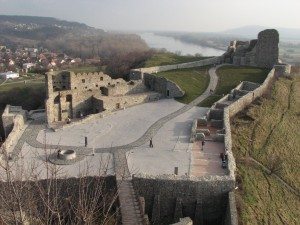 In the afternoon we find the crowded local bus to Devin castle, about 15 km out of town. Though there is a castle with a museum in town, it was rebuilt in the 1950s and everyone says that it is best viewed from afar. The ruins of Devin, however, are over 1,000 years old and sit on a hill overlooking the confluence of the Danube and Marova rivers. Surprisingly, the girls don’t whine on the walk up, and Ashley is warmed by mulled wine sold out of a car trunk in the parking lot. The views of the ruins and the sunny Danube valley, where we can see parts of Slovakia, Austria, and Hungary, are spectacular. We get back to town in time for sunset from the top of the UFO bridge, the antithesis to old town Bratislava, with an ultrachic restaurant and WC with a skyline view of the city.
In the afternoon we find the crowded local bus to Devin castle, about 15 km out of town. Though there is a castle with a museum in town, it was rebuilt in the 1950s and everyone says that it is best viewed from afar. The ruins of Devin, however, are over 1,000 years old and sit on a hill overlooking the confluence of the Danube and Marova rivers. Surprisingly, the girls don’t whine on the walk up, and Ashley is warmed by mulled wine sold out of a car trunk in the parking lot. The views of the ruins and the sunny Danube valley, where we can see parts of Slovakia, Austria, and Hungary, are spectacular. We get back to town in time for sunset from the top of the UFO bridge, the antithesis to old town Bratislava, with an ultrachic restaurant and WC with a skyline view of the city.
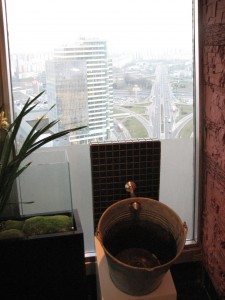 Ryan Air may be cheap, but they have the processing systems to prove it. We wait in line to pay for our one piece of luggage that is too heavy (not too big) to be a carry-on. We wait again to be segregated into those that paid to get on the plane first (none of the seats are reserved), and those like us that didn’t. And then we wait again to get on the plane. There are no jetways, just walks across the tarmac and those stairways on wheels you see in old movies. Ashley likens it to getting on a crowded bus. But the crowd is young and energetic, clapping and cheering on take-off and landing. And the flight is short, compared to the one getting us to Europe, and the bright yellow and blue plane interior keeps people awake.
Ryan Air may be cheap, but they have the processing systems to prove it. We wait in line to pay for our one piece of luggage that is too heavy (not too big) to be a carry-on. We wait again to be segregated into those that paid to get on the plane first (none of the seats are reserved), and those like us that didn’t. And then we wait again to get on the plane. There are no jetways, just walks across the tarmac and those stairways on wheels you see in old movies. Ashley likens it to getting on a crowded bus. But the crowd is young and energetic, clapping and cheering on take-off and landing. And the flight is short, compared to the one getting us to Europe, and the bright yellow and blue plane interior keeps people awake.
Though most people on the plane are headed for Barcelona, the plane is bound for Gerona, about an hours train or bus ride north of Barcelona. We’re staying in Gerona, however, where we’ve heard the medieval old town is worth a day of exploring and I’ve rented another couple of nights via the internet. The airport bus drops us in the city center, but the lack of a map, a street address of the apartment, or anyone that can speak with us in English at the contact telephone number makes finding the apartment an adventure. After the unplanned foot tour of the city, we’re guided to an amazing apartment in a 600-year-old building inside the old city alleyways and just outside the old Jewish quarter. The guy that runs the Hotel Historic spent six months refurbishing the place and we’re amazed we’re staying here.
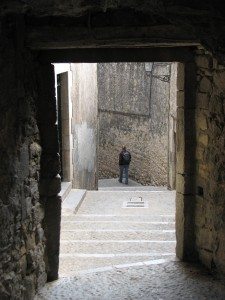 Gerona is definitely fun, with a cathedral on a hill over the Tyr river and an old city lined with protective walls. The colorful apartments along the river make for pretty scenery on sunny day walks over the many pedestrian bridges. And old city alleys on a hill are fun for exploring (more fun for Ashley than for the girls). Our first meal is Basque tapas, where the bar is covered with plates of various scrumptious things on bread, mostly seafood or ham oriented, and held together with a toothpick. My favorite is a ricotta-brie/blueberry jam/sardine/olive concoction that I replenish several times. The toothpick is important, because at the end of the meal you take them to the bar and pay for how many you’ve accumulated. We had 24 toothpicks, four beers, and two juices. Around the corner from the tapas place was a gelato-crepe stand to make perfect desserts!
Gerona is definitely fun, with a cathedral on a hill over the Tyr river and an old city lined with protective walls. The colorful apartments along the river make for pretty scenery on sunny day walks over the many pedestrian bridges. And old city alleys on a hill are fun for exploring (more fun for Ashley than for the girls). Our first meal is Basque tapas, where the bar is covered with plates of various scrumptious things on bread, mostly seafood or ham oriented, and held together with a toothpick. My favorite is a ricotta-brie/blueberry jam/sardine/olive concoction that I replenish several times. The toothpick is important, because at the end of the meal you take them to the bar and pay for how many you’ve accumulated. We had 24 toothpicks, four beers, and two juices. Around the corner from the tapas place was a gelato-crepe stand to make perfect desserts!
I should say that Gerona, and everywhere we’re going in Spain on this trip is in the province of Catalonia, where the primary language is Catalon and not Spanish. Though the languages are related and Zoey can still speak to most 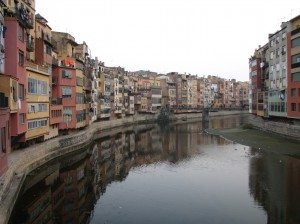 people in Spanish, it is no help that many tourist guides and TV shows are in Catalon first. I am pleasantly surprised at how easily Zoey speaks to people, especially when it’s just her and me and she knows I’ll be terrible in Spanish.
people in Spanish, it is no help that many tourist guides and TV shows are in Catalon first. I am pleasantly surprised at how easily Zoey speaks to people, especially when it’s just her and me and she knows I’ll be terrible in Spanish.
The rest of our trip is largely unplanned, an experiment to see if the girls can handle the anxiety that comes from not knowing where they might sleep that night. When traveling with kids we always talk about expectations for each day to relieve some of this stress, but for the next four nights we have no agenda. After a visit to the tourist office in Gerona, we take the train about half an hour north to Figueres, the site of Salvador Dali’s museum. The Lonely Planet says that Figueres is a bit of a dump, so we’re thinking that we’ll hit the museum and continue on to the coast later in the day. And like Bratislava, we’re a bit disheartened by the neighborhood around the train the station. But in a block or two, the dreariness soon gives way to the liveliness of the produce market (where 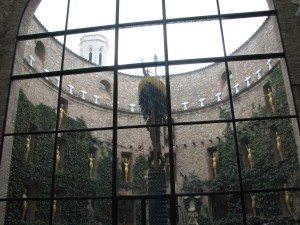 the kids buy some candy), and the well-kept Ramblas. Just off the main square Ashley goes into a hotel on a whim to see how much it costs, and by now we’re liking this town. Family accommodation is suitably cheap and we dump our bags in a clown-themed room. We head out to find the museum only two doors down. I’ve never been much of a fan of Dali, so my expectations weren’t very high. This only sets me up to be blown away. I’d seen postcards of the red building with giant eggs on top, but what I didn’t know is that the building had been a derelict theater that Dali himself spent over 15 years preparing to be not only his museum, but his tomb. We spent three hours inside, with an amazing array of questions from the kids, some of which I wasn’t prepared to answer. My favorite room was the main stage, under which Dali is buried, which has a giant forlorn painting under a dome and many smaller oddities. The stage opens out through a big window into the old theater, which is lined with golden statues and porcelain sinks. In the afternoon we climb a hill at the edge of town to watch the sunset from an old castle.
the kids buy some candy), and the well-kept Ramblas. Just off the main square Ashley goes into a hotel on a whim to see how much it costs, and by now we’re liking this town. Family accommodation is suitably cheap and we dump our bags in a clown-themed room. We head out to find the museum only two doors down. I’ve never been much of a fan of Dali, so my expectations weren’t very high. This only sets me up to be blown away. I’d seen postcards of the red building with giant eggs on top, but what I didn’t know is that the building had been a derelict theater that Dali himself spent over 15 years preparing to be not only his museum, but his tomb. We spent three hours inside, with an amazing array of questions from the kids, some of which I wasn’t prepared to answer. My favorite room was the main stage, under which Dali is buried, which has a giant forlorn painting under a dome and many smaller oddities. The stage opens out through a big window into the old theater, which is lined with golden statues and porcelain sinks. In the afternoon we climb a hill at the edge of town to watch the sunset from an old castle.
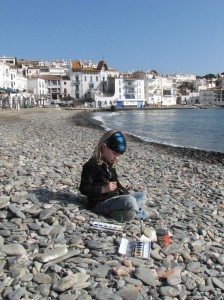 The next morning we do head for the coast, to Cadaques, about 80 minutes by bus from Figueres along a windy road through beautiful dry coastal hills. Cadaques is a small all-white town in a rocky bay, and home to Dali for a large part of his life. Most of the Costa Brava is closed this time of year, being dominated by British tourism in the warmer months. And Cadaques is no exception, with only a few of the dozens of hotels and restaurants open. I sit at the base of a Dali statue on the main beach and watch the kids comb through the rocks looking for beach glass and shells, while Ashley looks for a room. The local tourist office is closed too, and I can see Ashley on the other side of the bay walking between shuttered hotels. The best deal turns out to be the first place she finds, with a family room, complete with circular staircase, and a view of the water. And the place is dripping Dali, with paintings (some maybe even original) and photographs on every wall, and probably every book written about the guy in the sitting room. Our trip has turned into a Dali pilgrimage. Unfortunately, Dali’s house is closed, and so is the small Dali museum in town. But we fill two days hiking one direction along the coast, and then the other, spending a warm afternoon on our own little beach in a small cove. On the afternoon before we leave, the girls spend several hours painting rocks on the main beach, and leave them for other pilgrims to wonder about.
The next morning we do head for the coast, to Cadaques, about 80 minutes by bus from Figueres along a windy road through beautiful dry coastal hills. Cadaques is a small all-white town in a rocky bay, and home to Dali for a large part of his life. Most of the Costa Brava is closed this time of year, being dominated by British tourism in the warmer months. And Cadaques is no exception, with only a few of the dozens of hotels and restaurants open. I sit at the base of a Dali statue on the main beach and watch the kids comb through the rocks looking for beach glass and shells, while Ashley looks for a room. The local tourist office is closed too, and I can see Ashley on the other side of the bay walking between shuttered hotels. The best deal turns out to be the first place she finds, with a family room, complete with circular staircase, and a view of the water. And the place is dripping Dali, with paintings (some maybe even original) and photographs on every wall, and probably every book written about the guy in the sitting room. Our trip has turned into a Dali pilgrimage. Unfortunately, Dali’s house is closed, and so is the small Dali museum in town. But we fill two days hiking one direction along the coast, and then the other, spending a warm afternoon on our own little beach in a small cove. On the afternoon before we leave, the girls spend several hours painting rocks on the main beach, and leave them for other pilgrims to wonder about.
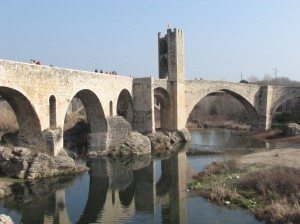 We take the bus back to Figueres, and another out the other side of town to Besalu, another old Roman town that is famous for its stone bridge. Zoey says that she is tired of old things, but we walk the old alleys once again and find a very nice hotel on the main square of the old town. It is dark already, which makes the alleyways that much more fun to explore, with stray cats, bats, and mice running underfoot. The bridge is beautiful at night too, lit by floodlight, with a classic castle gate mid-span. In the morning we do it all again in bright sunlight, because Besalu really is a small town with a fascinating history.
We take the bus back to Figueres, and another out the other side of town to Besalu, another old Roman town that is famous for its stone bridge. Zoey says that she is tired of old things, but we walk the old alleys once again and find a very nice hotel on the main square of the old town. It is dark already, which makes the alleyways that much more fun to explore, with stray cats, bats, and mice running underfoot. The bridge is beautiful at night too, lit by floodlight, with a classic castle gate mid-span. In the morning we do it all again in bright sunlight, because Besalu really is a small town with a fascinating history.
We get on the bus back to Gerona still carrying half the jug of sangria Ashley bought in Cadaques. On our last night we walk the medieval walls at dusk and watch the sun set over the Cathedral. We fly back to Bratislava the next day and are home to our house in Vienna by the middle of the afternoon. In hindsight, we didn’t cover much of Spain on our trip, or even much of Catalonia. There’s still skiing in the Pyrenees, the volcanoes and hiking outside of Olot, the medieval town on the edge of a cliff, and Barcelona. But we had a great time and only want to come back to do it all again. Ask Logan what she remembers of the trip now, two days later, and she can list every dog that she petted along the way.

